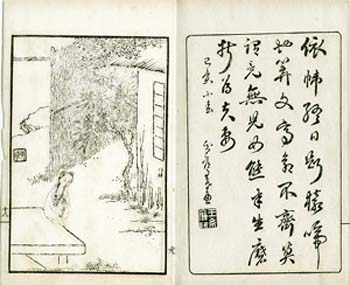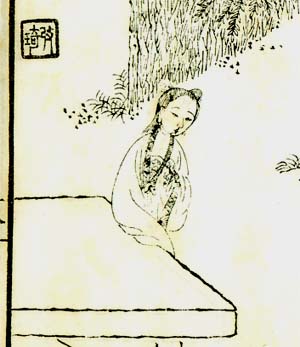Effects of Brush and Ink
CASE 3
Culture and International Relations in the 18th Century
The art market underlying the print industry in eighteenth- and nineteenth-century China was quite different from that in Europe. In China, the main interest of the artist was to express his own ideas and feelings, more than those of his subject, and convey them through his medium. A Chinese artist, like a Chinese calligrapher, usually expressed his emotions most directly through his or her brushwork. Therefore, the job of the engraver was to capture as accurately as possible the effects of the Chinese brush on paper. To achieve these results, woodblock engraving was probably more suitable than copper engraving.

Illustrated page by Gai Qi from the novel Hongloumeng tuyong (Pictorial and Poetic Tributes to Heroines of the Novel Dream of the Red Chamber, which was originally published
in 1879). This illustration is from the 1921 reprint.
Presented here is a print from a book published in 1879 with designs by Gai Qi, which illustrate romantic heroines of the famous novel Dream of the Red Chamber. The book’s title, A Collection of Gai Qi’s Pictures of Elegant Women, featured the artist’s name. In addition, the book displays the original calligraphy of many famous literati of the Qing Dynasty, each of whom wrote a poem on one or more of Gai Qi’s illustrations.
If you examine closely the printed calligraphy, you can see every detail of the brushwork, including straggling hairs in the character wen (writing), which is the third character down on the far-right side, or the tiny dribbles of ink that connected the strokes as the calligrapher’s brush moved rapidly along. Even the tone of the ink varies, thanks to the help of a highly skilled printer who inked the woodblocks individually and in various ways for each printed page.
This illustration also makes no attempt to hide the appearance of marks made by the woodblock on fine paper. The printed border is uneven to remind the reader that this is a handprinted product, and the artist was careful to provide a variety of brushstrokes, from extremely fine and fluid to rough and coarse, all of which have been captured by the wood engraver’s art. Gai Qi avoided illusionism, which critics associated with philistine taste, exploiting instead a more naive awkwardness, such as one finds in the work of some modern artists like Paul Klee or Ben Shahn. As the editor of this book writes in his preface:
Gai Qi was especially good at painting figures of elegant women,
using awkwardness [in his style] to reveal their charm.



